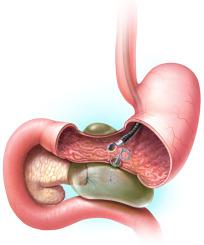当前位置:
X-MOL 学术
›
Gastrointest. Endosc.
›
论文详情
Our official English website, www.x-mol.net, welcomes your
feedback! (Note: you will need to create a separate account there.)
Acute and early EUS-guided transmural drainage of symptomatic postoperative fluid collections.
Gastrointestinal Endoscopy ( IF 6.7 ) Pub Date : 2019-12-13 , DOI: 10.1016/j.gie.2019.11.045 Andrew C Storm 1 , Michael J Levy 1 , Karan Kaura 1 , Barham K Abu Dayyeh 1 , Sean P Cleary 2 , Michael L Kendrick 2 , Mark J Truty 2 , Eric J Vargas 1 , Mark Topazian 1 , Vinay Chandrasekhara 1
Gastrointestinal Endoscopy ( IF 6.7 ) Pub Date : 2019-12-13 , DOI: 10.1016/j.gie.2019.11.045 Andrew C Storm 1 , Michael J Levy 1 , Karan Kaura 1 , Barham K Abu Dayyeh 1 , Sean P Cleary 2 , Michael L Kendrick 2 , Mark J Truty 2 , Eric J Vargas 1 , Mark Topazian 1 , Vinay Chandrasekhara 1
Affiliation

|
BACKGROUND AND AIMS
EUS-guided postoperative drainage (EUS-POD) of postoperative fluid collections (POFCs) is typically delayed until a thick wall has formed to optimize safety. Thus, percutaneous drainage is the mainstay of early POFC management. The primary aim of this study was to compare technical and clinical success and adverse event (AE) rate between early (0-30 days postoperative) compared with delayed (>30 days) EUS-POD. The secondary aim was to determine predictors for clinical success and AE rate associated with early compared with delayed EUS-POD.
METHODS
This was a retrospective analysis of consecutive patients undergoing EUS-POD between November 2013 and November 2018 at a single tertiary academic center. Demographic, procedural, and outcomes data were recorded. Clinical success was defined as resolution of symptoms and the fluid collection on cross-sectional imaging without recurrence after transluminal stent removal.
RESULTS
Seventy-five patients underwent EUS-POD; 42 (56%) were early, of whom 20 were acute. Sixty-three patients (84%) had undergone distal pancreatectomy. Technical success was 100%, and clinical success was achieved in 70 patients (93%) after a mean 2.2 procedures (range, 1-5). Prior percutaneous drainage had been performed in 13 patients (17.3%). Both acute and early drainage versus delayed EUS-POD demonstrated similar rates of clinical success (95% and 93% vs 94%, P = .99) and AEs (21.4% and 15% vs 30.3%, P = .43). Necrosectomy was required less often in the early versus the delayed group. No predictors of clinical success were identified. Early EUS-POD was not a predictor of AEs (P = .65). Infection and collection size >10 cm correlated with increased AE risk (P = .048 and .007, respectively).
CONCLUSIONS
Early and even acute EUS-POD of POFCs appears to be technically feasible, clinically effective, and safe. EUS-POD should be considered for definitive management of early symptomatic POFCs.
中文翻译:

对有症状的术后积液进行急性和早期 EUS 引导的透壁引流。
背景和目的 EUS 引导的术后引流 (EUS-POD) 术后积液 (POFC) 通常延迟到形成厚壁以优化安全性。因此,经皮引流是早期 POFC 管理的主要手段。本研究的主要目的是比较早期(术后 0-30 天)与延迟(>30 天)EUS-POD 的技术和临床成功率以及不良事件 (AE) 发生率。次要目的是确定早期与延迟 EUS-POD 相关的临床成功和 AE 率的预测因子。方法 这是对 2013 年 11 月至 2018 年 11 月期间在单个三级学术中心接受 EUS-POD 的连续患者的回顾性分析。记录了人口、程序和结果数据。临床成功被定义为症状的消退和横断面成像上的液体收集,在腔内支架移除后没有复发。结果 75 名患者接受了 EUS-POD;42 人(56%)为早期,其中 20 人为急性。63 名患者 (84%) 接受了远端胰腺切除术。技术成功率为 100%,平均 2.2 次手术(范围 1-5)后,70 名患者(93%)获得了临床成功。13 名患者 (17.3%) 曾接受过经皮引流。急性和早期引流与延迟 EUS-POD 的临床成功率相似(95% 和 93% 对 94%,P = .99)和 AE(21.4% 和 15% 对 30.3%,P = .43)。与延迟组相比,早期组较少需要进行坏死组织切除术。没有发现临床成功的预测因素。早期 EUS-POD 不是 AE 的预测因子 (P = .65)。感染和收集大小 > 10 cm 与 AE 风险增加相关(分别为 P = .048 和 .007)。结论 POFC 的早期甚至急性 EUS-POD 似乎在技术上可行、临床上有效且安全。EUS-POD 应考虑用于早期症状性 POFC 的最终管理。
更新日期:2019-12-13
中文翻译:

对有症状的术后积液进行急性和早期 EUS 引导的透壁引流。
背景和目的 EUS 引导的术后引流 (EUS-POD) 术后积液 (POFC) 通常延迟到形成厚壁以优化安全性。因此,经皮引流是早期 POFC 管理的主要手段。本研究的主要目的是比较早期(术后 0-30 天)与延迟(>30 天)EUS-POD 的技术和临床成功率以及不良事件 (AE) 发生率。次要目的是确定早期与延迟 EUS-POD 相关的临床成功和 AE 率的预测因子。方法 这是对 2013 年 11 月至 2018 年 11 月期间在单个三级学术中心接受 EUS-POD 的连续患者的回顾性分析。记录了人口、程序和结果数据。临床成功被定义为症状的消退和横断面成像上的液体收集,在腔内支架移除后没有复发。结果 75 名患者接受了 EUS-POD;42 人(56%)为早期,其中 20 人为急性。63 名患者 (84%) 接受了远端胰腺切除术。技术成功率为 100%,平均 2.2 次手术(范围 1-5)后,70 名患者(93%)获得了临床成功。13 名患者 (17.3%) 曾接受过经皮引流。急性和早期引流与延迟 EUS-POD 的临床成功率相似(95% 和 93% 对 94%,P = .99)和 AE(21.4% 和 15% 对 30.3%,P = .43)。与延迟组相比,早期组较少需要进行坏死组织切除术。没有发现临床成功的预测因素。早期 EUS-POD 不是 AE 的预测因子 (P = .65)。感染和收集大小 > 10 cm 与 AE 风险增加相关(分别为 P = .048 和 .007)。结论 POFC 的早期甚至急性 EUS-POD 似乎在技术上可行、临床上有效且安全。EUS-POD 应考虑用于早期症状性 POFC 的最终管理。











































 京公网安备 11010802027423号
京公网安备 11010802027423号